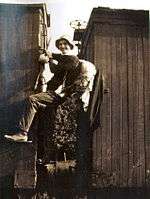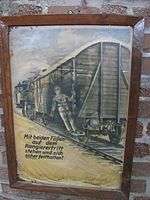Freighthopping

Freighthopping or train hopping is the act of surreptitiously boarding and riding a railroad freight car. In the United States, this became a common means of transportation following the American Civil War as the railroads began pushing westward, especially among migrant workers who became known as "hobos". It continued to be widely used by those unable to afford other transportation, especially during times of widespread economic dislocation such as the Great Depression. For a variety of reasons the practice is less common today, although a community of freight-train riders still exists.[1]
Technique

Typically, riders will go to a rail yard where the trains "crew change" (switch out crew). They will either know from other riders of a spot to hide and wait, or they will find one themselves. Depending on the size and layout of the yard, riders may have to get on the train while it is moving; doing this is known as "catching on the fly".[2] Furthermore, riders must figure out which way trains are going, either by calling the company's internal tracking number or by knowing which tracks go where. Riders will occasionally wait at "side outs", places where there are two parallel tracks and trains pull aside for others to pass.
Cars and trains are divided several ways with regards to riding. There are "IMs" (intermodal containers, also called "hotshots" or "double stack"), "junk" (mixed cars) and coal. Within these three groups some cars are "rideable" and some not: boxcars, grainers and gondolas are some of the rideable "junk" cars. On IMs, riders usually stay in the metal beds in front of or behind the shipping containers, "48/53 wells" or under tractor trailers "pig in a bucket" (when trailer is on a metal platform with large holes cut in the bottom. On coal, riders often get into "DPUs" or "rear units", which are the engines put on the back or middle of the train on long coal loads. Riding in the empty or full coal containers is also possible. Riding cars on the small exposed porch of a tanker, on a truss-bottom well car or any other position which exposes the rider to a great risk of falling off or getting caught is called "riding suicide".
Safety concerns

Freight-train riding has the reputation as being very dangerous and, to some degree, is in fact so. According to author and journalist Ted Conover, a large percentage of modern-day hobos are ex-convicts and violence is not uncommon among the transient population. This view contrasts with the established tradition of manners and hard work among "traditional hobos".[3]
Where train hopping is illegal, there is an inherent chance of arrest and/or ticketing. The amount of security and the attitudes of authorities vary greatly depending on the location. Increasing security has also presented a problem for train hoppers, though the establishment of legal protection for vagrants has led to a decline in the beating and maltreatment for which 'bulls' (railway security men) and brakemen became infamous, primarily through the overemphasis on violence in such popular culture manifestations as the film Emperor of the North (1973).
Because railroad companies can only patrol stopped trains, freight-hoppers embark and disembark while the train is in motion to avoid bulls. But freight train cars are not designed for human riders; hopping on (or off) moving trains bears serious risk of dismemberment[4] or death. In March 1899 Welsh "tramp-poet" W. H. Davies lost the lower part of his right leg after jumping a train at Renfrew, Ontario. The incident is recounted in his 1908 book The Autobiography of a Super-Tramp.
Riding the rods

In the 1900 to 1920 days of wood frame freight car construction, steel truss rods were used to support the underside of the car in order to provide it with the strength to carry heavy loads. There could be four or more of these truss rods under the car floor running the length of the car, and hobos would "Ride the Rods." Some would carry a board to place across the rods to lie on. Others would lie on just one rod and hold on tightly. Riding the rods was very dangerous. When a train moved at high speed, the cars could bounce and rock violently if the track was rough, and rock ballast might be tossed up which could strike a rider.
Modern day hopping
Hopping trains happens all over the world and varies from place to place. Some places are more critical on considering freight hopping a crime, and other places are more lenient. Freight hopping locations and routes are to be kept confidential and are only available through particular sources. This source is mostly shared physically, either by mouth or just passed on by hand. Exposure of this information can be problematic for hoppers since it may increase the dangers and difficulty of their travels. The railroad police, also known as bulls, have become more observant and careful when looking for train hoppers. The severity of the punishment depends on the location in which one is found.[5][6]
In popular culture
Film
- 1973 – Emperor of the North Pole (loosely based on Jack London's The Road).
- 1981 – Goodbye Pork Pie
- 1985 - The Journey of Natty Gann
- 1990s - Mr Bean
- 1985 – Runaway Train
- 1999 - Shiba Travel
- 2003 - Shiba Travel: Romi Adventure
- 2005 - Who is Bozo Texino? (film by Bill Daniel)
- 2007 – Into the Wild
- 2008 - Shiba Travel: Mountain
- 2010 - Taiko Drum Master
- 2011 - Little Star and the Animals
- 2013 - The East
- 2014 - Divergent
- 2014 - Jackie & Ryan
Literature
- 1907 – The Road, by Jack London
- 1908 - The Autobiography of a Super-Tramp, by W. H. Davies.
- 1958 - The Dharma Bums, by Jack Kerouac
- 1984 – Rolling Nowhere: Riding the Rails with America's Hoboes, by Ted Conover
- 1992 - "On The Right Track", by jwcurry
- 1993 – Hopping Freight Trains in America, by Duffy Littlejohn
- 1996 – Into the Wild, by Jon Krakauer
- 2006 – Enrique's Journey, by Sonia Nazario
- 2013 - The Adventures of Space and Hobo by Ken Birks
Music
- 1945 - "U.S.Highball", by Harry Partch
- 1961 – "Hobo's Lullaby," written by Goebel Reeves, performed by various people including Woody Guthrie and Pete Seeger
- 1964 – "King of the Road", by Roger Miller
- 1966 - "Early Morning Rain," by Gordon Lightfoot
- 1968 & on - "Hobo Chang Ba", "Clickety-Clack" & other songs by Captain Beefheart
- 1974 - "The Watchman’s Gone" by Gordon Lightfoot
- 1989 – "Here Comes Your Man," by the Pixies
- 1991 - "Never Tire of the Road," by Andy Irvine
- 2007 - "Sergeant Small", recorded on the album On the Fly by Irish folk band Patrick Street
- 2010 - "Hidamari no Uta", by Le Couple
- 2011 - "Vampires are Poseurs", by Ramshackle Glory
- 2013 - "Sergeant Small", recorded on the album Parachilna, by Andy Irvine & Rens van der Zalm
See also
References
- ↑ "Black Butte Center for Railroad Culture". Bbcrc.org. Retrieved 2015-07-08.
- ↑ Iverson, Wayne (2010). Hobo Sapien. Robert Reed Publishers. ISBN 1934759430.
- ↑ "Hobo News Hobo Code". Hobo.com. Retrieved 2015-07-08.
- ↑ PRESS, ASSOCIATED. "Boy critically injured trying to jump train in Northeast Philly". Newsworks.org. Retrieved 2017-07-22.
- ↑ "Crew Change Guide". hitchwiki. Retrieved 24 November 2015.
- ↑ "Geography of train hopping". hitchwiki. Retrieved 24 November 2015.
Further reading
- Uys, Errol Lincoln. Riding the Rails: Teenagers on the Move During the Great Depression (Routledge, 2003) ISBN 0-415-94575-5
- "Riding the Rails", American Experience PBS series.
External links
| Wikiquote has quotations related to: Freight-hopping |
- Hobo Letters Letters from boxcar kids who rode the rails during the Great Depression